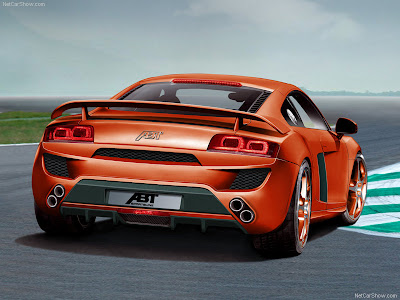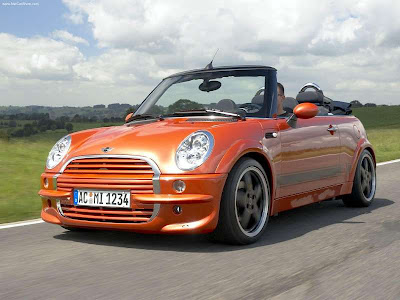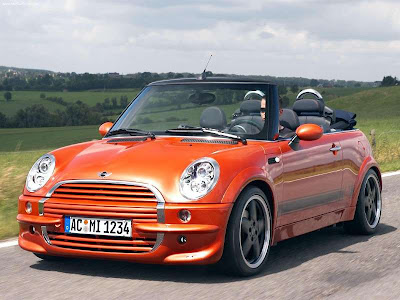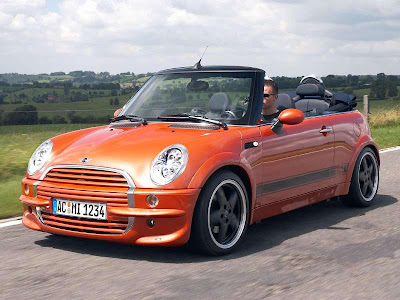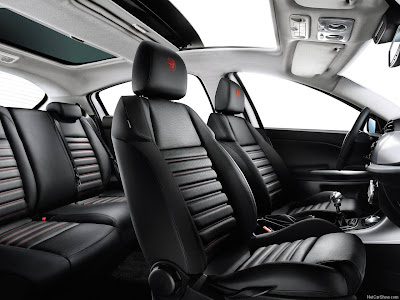




The Lamborghini Murcielago is one of the most extraordinary super sports car of all time. Automobili Lamborghini has expanded its range of models with a new, exceptionally purist model and even more extreme - the Lamborghini Murcielago LP670-4 SuperVeloce is more powerful, lighter and faster than the Murcielago LP640. With the departure of the 6.5 liters V12 increased to 670 hp and a weight reduction of 100 kg (220 lbs), the Lamborghini Murcielago LP670-4 has a power-SuperVeloce weight of 2.3 kg (5.1 lbs ) by CV. This catapults from 0 to 100 km / h (62 mph) in 3.2 seconds and skills that a top speed of around 342 km / h (212 mph). Distinctive design enhancements ensure that each of the 350-unit limited edition series transmits its full potential from the first glance.
With its outstanding performance, razor-sharp precision and stability for exceptional high speed, the Lamborghini Murcielago LP 670-4 is the latest car SuperVeloce performance sports car for the drivers. The super sports car has been redesigned with a new front and rear, a new hood and a choice of two aerodynamic setups with either a small or large rear spoiler. The interior Alcantara and carbon fiber provides a purist and minimalist approach.
In order to achieve significant weight reduction of 100 kilograms (220 pounds), the Lamborghini Murcielago LP670-4 SuperVeloce was extensively revised and reconstructed in virtually every aspect - from chassis to engine and transmission to the interior. The increase in production of engines from 640 to 670 hp is the result of the optimized valve timing and a modified intake system. Aerodynamics significantly modified with a substantial increase in load results in significant improvement in vehicle stability at high speeds. With the standard setting of a small rear wing, maximum speed is 342 km / h (212 mph), while the large "Aeropack Wing," and added his load gives a maximum speed of 337 km / h (209 mph).
"The new Lamborghini Murcielago LP670-4 SuperVeloce is the continuation of the systematic philosophy of our brand. It is more extreme, and without almost any other car," said Stephan Winkelmann, President and CEO of Automobili Lamborghini. "As the new top model of the successful Murciélago range, the sample SuperVeloce not only exceptional driving dynamics, it is also further evidence of our expertise. Customers can expect a totally unique driving experience."
Design and Aerodynamic
The Murciélago is a icon Lamborghini - a machine sporting a menacing and brutal power. Its unique design radiates a supreme highly concentrated form of sensuality. Wide, low area with its glass pushed way forward and a long and tense again - the interaction between the soft contours of the basic shape and sharp edges is the perfect expression of the Lamborghini design language. In all of its character, the Murcielago is unmatched in the market for sports cars.
However, even a character like this can be improved - the new SV Lamborghini Murcielago LP 670-4 is the most extreme, most purist pinnacle of the range of models. This is evident from the first glimpse of their totally redesigned front end - pulled way forward and finished in matt black paint, the front spoiler carbon fiber connects to the front through two vertical elements. The large air intakes for the front brakes are more strongly emphasized. The new feature of the front air defenses for the additional brake ventilation. The air vent for the oil cooler located in the driver's side, the threshold is painted matte black to match the ceiling.
The changes are even more evident in the powerful engine bay Lamborghini Murcielago LP670-4 SuperVeloce. The twelve-cylinder engine is a masterpiece of engineering under a transparent hood that has a completely new architecture. Hexagonal plates made of transparent polycarbonate polymer is set at three levels within a framework of carbon fiber. The layers are open in the back, playing a key role in the thermodynamics of high-performance engines.
The impressive final SuperVeloce rear is dominated by a truly noble, flat and wide and the exhaust pipe at the bottom, by a broadcaster in the two-tier system of fully finished carbon fiber. The backlight display their signs in groups such as distinctive and has been a fixed design as the Lamborghini Murcielago LP 640, and Reventon LP560-4 Gallardo. The group of experts from the lamps is made from carbon fiber, while the large mesh below the intake expands across the width of the rear. Made of thick aluminum walls, the hexagonal pattern is laser cutting and a Teflon coating provides the necessary thermal protection.
The aerodynamics of the Lamborghini Murcielago LP670-4 has been fully reviewed SuperVeloce. Along with the expansion of the front spoiler and rear diffuser double, the new fixed rear spoiler also plays an important role. Customers can choose between two versions, with the small rear wing to provide better aerodynamic loads at high speeds. Optionally, the Lamborghini Murcielago SV LP670-4 can be supplied with "Aeropack wing" - a large, fixed carbon-fiber wings mounted on two carbon fiber brackets. The new aerodynamic configuration provides a significant boost to the directional stability at high speeds. The maximum speed of the load on the Lamborghini Murcielago LP670-4 SuperVeloce with Aeropack is a sharp increase.
Bodywork and lightweight construction
With the construction of the Murciélago LP 670-4 SuperVeloce, Lamborghini showed their experience in the manufacture of lightweight materials and working with high-tech carbon fiber. The structure of the super sports car is an extremely rigid construction of composite components and a carbon tubular steel frame - like a race car. The transmission tunnel and floor are made of carbon fiber, which is attached to the use of steel rivets and high strength adhesives. The roof and exterior door panels are formed of sheet steel, while the rest of the outer skin is made of carbon composite material.
For the Lamborghini Murcielago LP670-4 SuperVeloce, engineers in the Sant'Agata Bolognese recalculated and select a new, super high strength steel section. This achieved two objectives - firstly, that increasing the torsional stiffness of the chassis by 12 percent for improved handling precision, and secondly, they were able to reduce the weight of 20 kg (44 lbs) making a significant contribution to the reduction of overall vehicle weight. The systematic approach is still lightweight design throughout the body. The front fenders, rear fenders and groups or the cover of the third brake light are made of a material change in the carbon fiber. Combined with the elimination of the mobile unit to the wing, this brings a greater reduction in weight of 13 kg (28.6 lbs).
Added to 33 kg (72.6 lbs) of weight reduction and chassis exterior is 34 kg (74.8 pounds) from the inside, as well as more than 33 kg (72.6 lbs) removed from the unit engine and train.
Power unit and transmission
The 6.5 liters longitudinally mounted V12 power supply for an infernal incomparable driving experience. With 670 hp (493 kW) engine in the Lamborghini Murcielago LP670-4 SuperVeloce is 30 hp more powerful than the Murciélago LP 640. The twelve-cylinder sends his mighty 660 Nm (487 lb.-ft.) of torque to the crankshaft at 6500 rpm, maximum power is reached at 8000 rpm, with an average speed of piston 23.7 meters per second - a figure almost comparable andalusia the engines of the race.
The V12 is ready to deliver results - which brings its menacing power with the immediacy and accuracy to ensure impressive performance - after just 3.2 seconds, the SuperVeloce has already reached 100 km / h (62 mph).
The engine block and the heads of the V12, located in the ideal cylinder angle of 60 degrees, are made of aluminum. The chain of four camshafts are driven controlled variable, while the intake manifold in three stages - two technologies add even greater impetus to the relentless pushing power. To enhance the performance of the Lamborghini Murcielago SV LP670-4, the intake system has been changed, the valve train and optimized, especially the increased valve travel.
The control electronics for the V12 have been developed internally by Lamborghini - each cylinder bank has its own high-performance processor. If the engine requires more cooling air, intake funnels emerge from the rear pillars when not in operation, they are flush with the bodywork. Dry sump lubrication allows the V12 to be mounted very low to the benefit of handling dynamics, this also ensures the supply of oil under very dynamic driving conditions. With 12 liters of lubricant oil in circulation, the oil cooler is on the left side of the vehicle and cooled air that flows through the opening in the doorway.
Weight loss of more than 26 kg (57 pounds) in the engine area is derived mainly from the new exhaust system. The muffler has been redesigned and powerful tube of SuperVeloce made from new material is lighter than the Murcielago LP 640. But above all, the new exhaust system for an acoustic experience that is certainly equal to driving - from the heavy rumble of a stormy night, through the powerful trumpeting of elephants for the angry roar of a lion, the Lamborghini Murcielago LP670 -4 SuperVeloce performs grand opera on 12 cylinders, 48 valves and 8000 revolutions.
The Lamborghini Murcielago LP670 SV-4 is equipped with the sequential e.gear automated manual transmission, which uses electro-hydraulics to change gears quickly and smoothly. A booth display informs the driver of the art today. In addition, a special "Corsa" mode and a "low adhesion" mode are available.
As there is the option premium, the SuperVeloce is available with a six-speed manual transmission. His step short metal pole running on an open door of the classic Italian style. In both variants, the new lighter clutch makes its own contribution to the weight loss program.
All the wheels and chassis
The Lamborghini Murcielago LP670-4 SuperVeloce offers extreme power to the road with great reliability - assured by its constant all-wheel drive. Before turning the rear wheels, the viscous coupling to send 35 percent of power through the shaft in addition to the front wheels. The front and rear limited-slip differentials are set at 25 to 45 percent. With its four-wheel traction and momentum, the Murciélago offers a decisive advantage over the rear wheel sports when accelerating from a corner - and with maximum stability. The rear axle carries 58 percent of its overall weight - a distribution coefficient which is very good for traction.
Explosive dynamic, tenacious and extreme speed curves - the Lamborghini Murcielago LP670-4 is a super sports car SuperVeloce full of aggressive power, but in no way means a bad car. Your address requires very little energy support, giving full control to the driver of the vehicle. Preparations to face the beast in the head are quickly rewarded with intimate contact and confidence - as speed increases, so the bat reveals its strengths, thus exposing a character's behavior without surprises and you can always be expected.
The Murcielago is equipped with dual suspension Wishbone all. Struts spring - two in each of the rear wheels and one in each of the front - the control of the loads transferred from the road. The level of elevation adjustment system allows the front end of vehicle to be raised by 45 mm (1.8 inches) to avoid obstacles such as parking tickets. SuperVeloce is equipped with the exclusive "Ares" forged alloy wheels, with the unique double five spoke design. The front wheels are clad in 245/35 ZR 18 rubber while 335/30 ZR breeding sport 18. High adhesion Pirelli P Zero Corsa tires are standard.
Four brakes controlled by a high-tech powerful ABS system capable of stopping power when needed. The ceramic carbon (BCC) are enlivened by the brake cooling air flowing through channels extending into the body, while the openings in the front fenders provide additional ventilation for the Lamborghini Murcielago LP670-4 VS. The ceramic discs are exceptionally lightweight, fade-free and capable of very high operating performance.
Interior and Equipment
Even in the intensification of the Lamborghini Murcielago SV is a very personal experience as the car itself. The upward-opening doors - a solution developed by Lamborghini in the early seventies for the Countach - are released through small locks, and then swing open to reveal a panorama of the interior of the exclusive Lamborghini Murcielago LP670 -4 SuperVeloce. The dominating materials are Alcantara and carbon fiber, making an environment that is as high quality as it is sporty.
The sport seats come standard with an exceptional and provide firm support around the hip and shoulder areas. The seats are made of sturdy and lightweight carbon fiber and ensure perfect driver support, even in the most extreme conditions. The bat standard seats are also available at SuperVeloce as a free option.
Not only the seats are upholstered in Alcantara black micro fiber, the cab and the roof lining is finished in this high-quality, lightweight material. And the form of holes in the seats and the roof rather than finesse, inlaid with a backing material in the same color as the exterior paint. The Lamborghini Murcielago LP670-4 SuperVeloce can be delivered with paint finishes Giallo Orion, Arancio Atlas, Isis Bianco, Grigio Telesto and Nero Aldebaran and Bianco Canopus (matt white) and Nero Nemesis (matt black) as an option.
Naturally, the interior also contributes to weight reduction. The door panels are covered in carbon fiber, as is the center of the tunnel. The application of leather instead of Alcantara is another weight-saving, like the choice of sports seats and the failure of radio-navigation system (if requested, is available as an option). At the end of the day, music comes from a bat in the engine compartment. In general, changes to the interior contribute more than 34 kg (75 pounds) to the SuperVeloce weight loss program.
But absolutely no corners have been cut when there is a feature that is characteristic of all Lamborghini super sports cars - the exceptional quality of workmanship. Artisans in Sant'Agata Bolognese Åre all masters of their trades, the guarantee of three years is testimony to the faith in the product quality.
Technical data - Lamborghini Murcielago LP670-4 SuperVeloce
Frame: tubular steel structure with high strength carbon fiber components
Body: carbon fiber, except roof and door external panels (steel)
Steering
Type: Mechanical (rack) power assisted
Right-hand rotation: 12.55 meters (41.17 feet)
Wheels and tires
Front: 245/35 ZR 18 "
Rear: 335/30 ZR 18 "
Motor
Type: 12 cylinders at 60 °
Bore and Stroke: 88mm x 89 mm (3.46 x 3.50 in)
Displacement: 6496 cc. (396.41 in ³)
Compression ratio: (11 ± 0.2): 1
Maximum Power: 670 hp (493 kW) at 8000 rpm
Maximum torque: 660 Nm (487 lb.-ft.) at 6500 rpm
Position in a motor vehicle Rear central longitudinal
Cylinder head and engine block: Aluminum
Intake system: Variable geometry with 3 operating modes
Calendar
4 valves per cylinder, 4 camshafts general
Timing gear transmission 2 chains
Calendar continuous variable (int. and ex.) Electronically Controlled
Ignition system
Type of ignition timing system with individual coils (one per spark plug).
Ignition sequence: 1-7-4-10-2-8-6-12-3-9-5-11
Fuel system / injection
Lamborghini LIE electronic control unit of the engine, multipoint, sequential time, the drive cable
Lubrication system
Type: Dry sump
Recovery pumps 2 gear pumps
Delivery pump (high pressure) 1 gear pump
Cooling System
Type: liquid-cooled, with the pressure of the circuit
Transmission
Transmission type: Permanent all-wheel drive traction system with Viscous
Gearbox: 6-speed e-art
Clutch: Dry single disc
Clutch disc diameter 272 mm (10.7 in)
Transmission coefficients
Traction Control System: T.C.S.
Gearbox - Manual and E-Gear
1: 1:3.091
2nd: 1:2.105
3rd: 1:1.565
4th: 1:1.241
5: 1:1.065
6: 1:0.939
Reverse: 1:2.692
Brakes
4 self-ventilated rotors with pedal control, hydraulic transmission with two independent circuits, one for each axle with vacuum servo.
ABS antilock device + DRP function
Carbon ceramic brakes (CCB)
Handbrake: mechanical acting on rear wheels
Front Rotor: Ø 38 x 380 mm (Ø 14.96 x 1.5 in)
Front caliper cylinders: n.6 (32-36-38 mm) (1.26 in -1.42 in 1.5)
Rear Rotor: Ø 38 x 380 mm (Ø 14.96 x 1.5 in)
Rear caliper cylinders: n.6 (32-36-38 mm) (1.26 in -1.42 in 1.5)
Suspension
4-wheel independent articulated quadrilateral system. Hydraulic shock absorbers and coaxial coil springs. Front and rear suspension with dual struts, anti-roll, anti-dive and anti squat bar.
Dimensions
Wheelbase: 2665 mm (104.92 in)
Length: 4705 mm (185.23 in)
Overall width: 2058 mm (81.02 in)
Overall height: 1135 mm (44.69 in)
Empty Weight: 1565 kg (3450.2 lbs)
Front track width: 1635 mm (64.37 in)
Rear track width: 1695 mm (66.73 in)
Front: 1090 mm (42.91 in)
Rear: 950 mm (37.40 in)
Maximum overall width with external rear: 2240mm (88.19 in)
Weight distribution front / rear: 42% - 58%
The capacity of liquid
Fuel tank: 100 liters (26.4 gal)
Motor oil: 12 liters (3.17 gallons)
Gearbox oil: 3.5 liters (0.92 gallons)
Front differential oil 1 liter (0.26 gallons)
Rear differential oil: 2.5 liters (0.66 gallons)
Cooling: 15 liters (3.96 gallons)
Performance
Start with a small spoiler speed: 342 km / h (212.5 mph)
Top speed with big wings: 337 km / h (209.4 mph)
Acceleration 0-100km / h: 3.2 s
Fuel consumption (according to DIR 1999/100/EC)
City: 32 l/100km
Highway: 13.7 l/100
Combined: 20.6 l/100
CO2 emissions: 480 g / km
U.S. fuel consumption (according to guidelines of the U.S. EPA)
Manual
Cycle City: 8 mpg
Cycle of the highway: 13 mpg
Combined: 10 mpg
E-Gear
Cycle City: 9 mpg
Cycle of the highway: 14 mpg
Combined: 11 mpg










